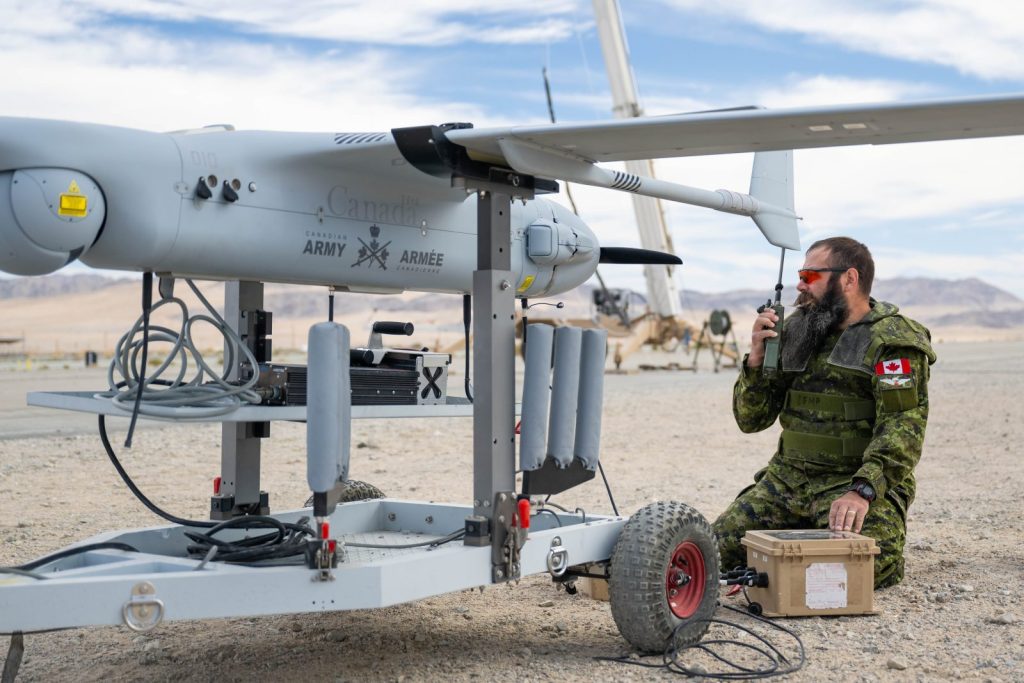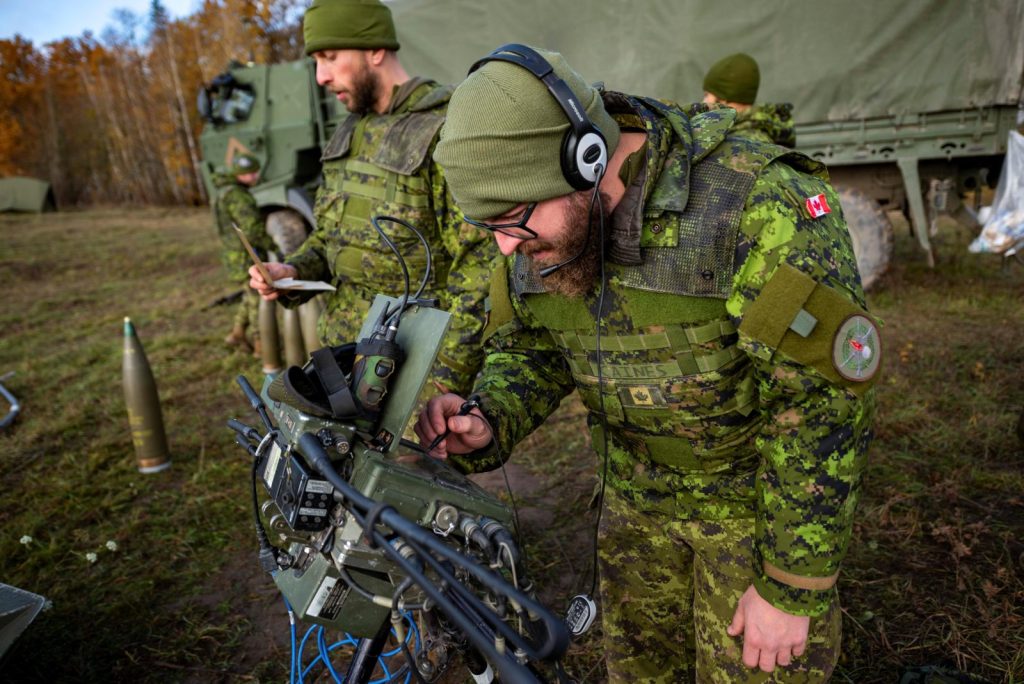As the brigade in Latvia takes shape, a liaison cell will help with how new equipment is fielded.
by Chris Thatcher
When Operation Athena transitioned from Kabul to Kandahar province in late 2005, and more heavy equipment began arriving in theatre to support the counterinsurgency mission, the Army deployed a technical liaison officer to gather data on behind armour effects of improvised explosive devices and any technical failures of vehicle protective systems.
In the battle against the proliferating IED, that data was vital. It helped the Army understand effects on its own equipment and make the case for up-armouring LAVs and introducing new and better protected platforms.
“We worked with Defence Research and Development Canada and other partners to find solutions, fix issues, and defeat the various adversarial challenges we had in Afghanistan,” recalled Colonel David MacIntyre, who served as the first liaison officer. “And each rotation did a lot of interesting work in terms of bringing in and integrating new equipment.”
Now, as Director Land Requirements (DLR), he is ensuring that same technical lessons gathering process is in place for Operation Reassurance in Latvia — a channel back to the organizations acquiring urgent equipment and sustaining capability as the multinational battle group expands to the strength of a brigade.
Last September, the first technical officer liaison (LO) cell, a two-person team from DLR and Assistant Deputy Minister (Materiel) (ADM Mat) branch, arrived in Camp Adazi to begin establishing the process for observing exercises and collecting hard data and anecdotal feedback from soldiers.
The cell has four lines of effort (LOE) around equipment sustainment, the introduction of new capabilities, procurement processes, and as a communications conduit between commanders in theatre and organizations in Canada when it comes to the previous three LOEs.
As the brigade grows, the first is intended to address issues, including sustainment associated with an increase in vehicle fleets. Whether it’s more LAV 6.0s, Leopard 2A4M tanks, M113 variants, logistics trucks or, eventually, Armoured Combat Support Vehicles, as well as other equipment such as M777 howitzers, how those fleets are maintained will be critical to mission success.
The second LOE is around the introduction and integration of urgent operational requirements (UORs) such as portable anti-X missile systems (PAXM), counter uncrewed aircraft systems (CUAS), and air defence (AD) and other capabilities like loitering munitions (LM), light tactical vehicles (LTV), load carriage vests, general-purpose mini drones, and command-and-control (C2) systems.
Some are new; others are lapsed capabilities that will need to be relearned. And many, like the Integrated Soldier System of TAK-enabled software and the cloud-based nodal tactical network, are still being refined through ongoing experimentation.
“There’s a need to understand all the integration efforts that make those a capability – individual training on a platform or weapons system, the support tail that goes with that, the integration with other capabilities to make sure you are tactically able to use that system,” said MacIntyre.
“The tech LO’s job will change overtime from helping deliver the equipment, to identifying the lessons of bringing some of these new high-end capabilities to the Army. Reintroducing air defence, for example, is not a small feat.”

Gunners from 129 Battery, 4th Artillery Regiment (GS), with the CU-172 Blackjack during Ex Mojave Gunner in Twentynine Palms, CA, as part of their mission rehearsal training for deployment to Latvia. Photo: MCpl Stephanie Labossiere
The third area of focus is shoring up the procurement system for items needed in theatre. To avoid duplication of effort by the brigade and organizations in Ottawa like DLR and ADM (Mat), the liaison cell will help streamline communication for minor procurements such as night identification patches. Those items might be small, but they can have sustainment requirements. Moreover, they often need to be acquired quickly.
The fourth LOE knits together the other three. Weekly conference calls with DLR and ADM (Mat) provide situational awareness for all, allowing the tech LOs to bring forward requests for information from the brigade and from lifecycle material managers to track equipment issues.
“That comms piece is helping ensure that the brigade knows what (capability) is coming in, and that our teams here are getting back information on its use — what’s working, what’s not, and what needs to be improved,” said MacIntyre.
Critical to that has been the buy-in of soldiers in Latvia to the feedback loop, sharing their experiences with new systems and flagging problems or gaps in capability.
“That lean forward by those troops has really helped us land some of this capability,” he said.
The communication link is also ensuring lessons gathered from the introduction of UORs like air defence and light tactical vehicles inform the project teams for Ground-Based Air Defence (GBAD) and Light Forces Enhancement as they finalize requirements and move toward requests for proposals.
“The job is really to facilitate the introduction of the new equipment, but their reports will capture a commander’s assessment of that equipment, which will hold a lot of weight for a future project,” MacIntyre noted.
The 4th Artillery Regiment (General Support), which will employ both the air defence UOR and the future GBAD solution, already has medium range radars and an aerospace coordination platform “integrated into how the Latvian airspace is controlled,” he said, so they are well positioned to accept and train on the Saab RBS 70 NG short-range air defence system when it arrives. “That is part of the relationship for the LO, communicating and guiding those decisions from the experts (in the field) back to us in a relevant format.”
While the Army has plenty of experience with UAS, including with the current Boeing Insitu CU-172 Blackjack and the AeroVironment CU-173 Raven, the addition of a commercial general-purpose system at the platoon or company level “opens the aperture” on a greatly expanded level of sensing. But that, too, will require tech LO involvement as the Army seeks to better understands how to employ those assets.
“We have had UAS for some time, but not in the numbers we are seeing being used and attrited in current conflicts,” said MacIntyre. “This will be our opportunity to really start integrating a capability set of UAS and CUAS into more levels of our tactical formations.”

A member of Dragon Battery from the battle group in Latvia makes fire direction control adjustments for a M777 Howitzer during Ex Wawel Dragon in November 2023. Photo: Capt Joffray Provencher
The liaison cell will also have an information gathering role in the experimentation of capabilities that are first trialed in domestic exercises and, if successful, rapidly pushed forward to Latvia. MacIntyre noted that while the Army may have a vision for how equipment will be employed, complex exercises often “identify the right configuration of capability to generate combat power.”
For instance, no two soldiers are using the applications in the Integrated Soldier System suite the same way, he added, “but they will generate best practices” through experimentation.
The cells are on a roughly five-month rotation, arriving in Latvia once a new rotation of the battle group has assumed training and large-scale multinational exercises, and then departing once that battle rhythm subsides and the battle group prepares to rotate out.
Two rotations in and already the Army is seeing dividends, MacIntyre said. “The information coming back is proving to be valuable as we move these programs forward. On the first roto, we had a good report on some of the challenges supporting the LAVs, and now we understand that fleet much better.”

